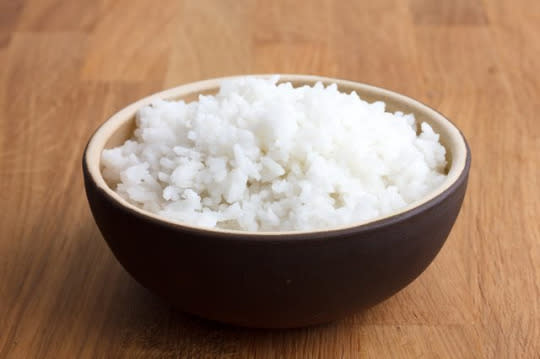5 Tricks That Will Change the Way You Eat Carbs Forever

Cooking rice with coconut oil, then cooling can potentially cut calories in half! (Photo: MovingMoment/Adobe Stock)
Carbohydrate-rich foods may get a bad rap by some nutritionists. But they often get “thumbs up” by consumers for deliciousness. Fortunately, you can eat foods like pasta, rice and potatoes in ways that make them healthier for your body. You just need to follow a few easy tips from your very own kitchen.
COOKING TIP #1: Cook rice with coconut oil, then chill.
Don’t forget the protein and fat: Each can reduce glycemic responses of starchy foods. For instance, enjoy rice as part of a balanced meal that includes a protein-rich food and a source of healthy fat, like chicken and avocado or tofu and peanuts. Want to go one step further? Cook rice along with coconut oil, then cool it to significantly boost resistant starch (perhaps tenfold) and potentially cut in half the calories. Research conducted at Sri Lanka’s College of Chemical Sciences suggests this: Add a teaspoon of coconut oil to boiling water, add a half-cup of unfortified white rice, simmer for 40 minutes, then refrigerate for 12 hours. It’s OK to reheat it afterward.
HINT: Choose brown, red, purple or black rice rather than white rice when possible for whole-grain benefit and cuisine intrigue. The naturally occurring plant pigment that gives a specific rice its color, like anthocyanins in purple rice, further promotes health.
COOKING TIP #2: Eat your bananas slightly unripe.
Resistant starch, considered a form of dietary fiber, resists digestion by your body. This implies that foods high in resistant starch can be helpful for managing blood sugar levels. They can potentially help promote good bacterial growth since the starch may be considered a prebiotic, or food for probiotics. Because unripe bananas contain more resistant starch compared to ripe bananas, consuming slightly green bananas rather than fully ripened (cheetah-spotted) ones can be a better health bet. Bye-bye, brown spots.
HINT: A banana counts as a fruit serving. Use the fruit to provide natural sweetness in baking while helping you use less added sugar.
Related: Cut Calories With These 9 “Pasta Poser” Recipes
COOKING TIP #3: Cook, then cool, potatoes.
Let your potatoes chill out. When cooked and cooled, starchy foods are higher in resistant starch than when not cooled. We can’t digest resistant starch so the sugar is broken down or absorbed by the body. Based on a study in ileostomy patients published in Advances in Nutrition, freshly cooked potatoes had slightly lower amounts of resistant starch than potatoes that were cooled. This seems to occur due to a realignment of potato starches after cooling.
HINT: A potato is a starchy vegetable, but it’s still a vegetable. Scrub and keep the skin on to ultimately boost fiber and antioxidant intake. It may also slow down digestion.
COOKING TIP #4: Buy bigger oats.
Oats are a whole-grain food and an excellent source of soluble fiber. But they’re not all created equal. Research published in the British Journal of Nutrition finds that the smaller the particle size, the higher the glycemic response. So bigger is better. A sampling of their GI findings suggests large-flake oats, steel-cut oats, muesli and granola provide a low to moderate glycemic response; quick-cooking oats and instant oatmeal cause a high response. So skip the instant and quick-cooking oats and savor a bowl of large-flake or steel-cut oats instead.
HINT: Oats start as a healthful pick. What you add to them can transform them into a less or more healthful option. Consider savory rather than sweet options.
Related: 10 Tasty Tips for Cutting Carbs From Your Diet
COOKING TIP #5: Nosh on noodle leftovers (and serve salad beforehand).
Pasta “planned-overs” are the way to go. Based on a BBC television show experiment, by cooking pasta, cooling it and reheating it, the post-meal rise of blood sugar was reduced by 50 percent compared to eating freshly prepared pasta. (Stay tuned for science-based findings in the future). What’s more, scientific research does find that eating a healthful salad before a pasta meal may enhance satiety, reduce calorie consumption and increase vegetable intake.
Specifically, a study published in the journal Obesity finds that enjoying a salad before a pasta entree may reduce total meal intake by approximately 123 calories when compared to having no salad. And a separate study published in Appetite finds that eating a low-calorie salad before (instead of with) the main course may boost veggie intake by 23 percent!
HINT: Remember to consider size and selection. Think in terms of “cupful” rather than “bowlful” of pasta or other noodles. Whole-grain noodles like whole-wheat spaghetti are a healthier bet than refined “white” pasta any time.
Click here to see two more way to change the way you eat (and cook!) carbs.
By Jackie Newgent, RDN, CDN
More from LIVESTRONG.COM:
8 Tricks to Keep Your Metabolism Revving